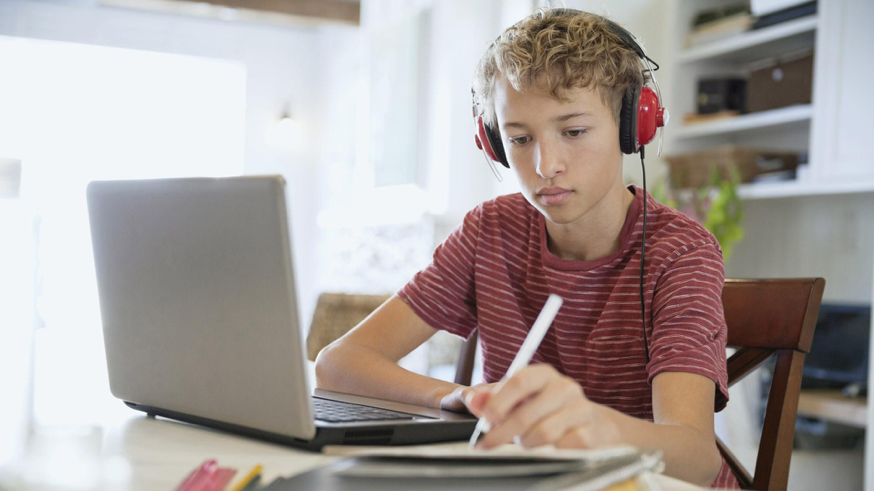Tips for Parenting Children in the Coronavirus Era: Transitioning to Online Learning


The COVID-19 and accompanying stay-at-home orders have created a lot of changes and adjustments to our everyday life. One major change is the shift many schools have made to offering online learning. While online learning is not a new concept, for many of you who haven’t intentionally chosen this method of learning for your child, the idea of it may seem daunting, and may create skepticism about the quality of education that your child can receive. Your child may also experience similar feelings. Below you will find a discussion on what you may expect with regards to online learning and tips on helping your child better adjust to this new educational experience.
1. Understanding your role
Knowing what role you will play in this new educational structure can be the first step to helping you assist your child in navigating online learning. While the teachers are at the forefront of your child’s education, you may find yourself needing to provide additional instruction or support with both their educational curriculum and on how to use the online educational platforms (e.g. Google classroom/Google Meet).
As part of your child’s educational team, increase communication with teachers and school administrators to ensure you’re understanding classwork and homework assignments, how to provide the best assistance to your child, as well as to gain assistance with using the technology and online platform.
2. Navigating schedules
Your own personal schedule and tasks may also differ now depending on whether or not you’re working from home. You are likely feeling as though you have more on your plate now than ever, as you navigate your own work schedule, your child’s schedule, and house tasks. Therefore, it is helpful to create a schedule and structure to allot time for your own work responsibilities as well as keeping up with your child’s work.
Adhering to a set schedule is crucial for better time and stress management for yourself and for your child, and will help in reducing behavioral challenges. This will also allow them to understand what is expected of them, and when you are available to them for help or fun. This is especially helpful for younger children who require more assistance in understanding their expectations and organizing their time.
With teens, it will be helpful to create a schedule with them, allowing them to give input and feel as if they have some control over what their day will look like (plus, this is a good time to teach teens time management/organization skills, so don’t just do it for them).
3. School schedule and break times
Just as you create a schedule for yourself, create one for your child. Visual schedules are especially helpful to increase predictability and adherence to such schedules. Remember, your child’s regular schedule and routines have been disrupted, and they will likely need assistance in setting up a new wake-up time (e.g. if it changes due to no longer having transportation time to account for), reminders of school hours, homework time, times for breaks, chore times, and bedtimes. It is best to keep to their regular bedtimes for consistency (and to help manage difficult moods and behaviors that can come up due to lack of sleep).
Incorporate break times throughout their day, including lunch or recess time. Additional breaks may be necessary, as they are now on the computer more and it is important to give their eyes a break from staring at a screen for extended periods of time. Small breaks can include standing up to stretch or some other form of movement, going outside, snack time, playing with or petting the family pet, etc. These breaks will help to release energy and increase focus on their work. Be clear about playtime. This is usually best reserved for longer breaks (e.g. recess, lunch time) or at the end of the school day, as this can serve as a motivator for them to first focus on schoolwork.
With the extra time children have these days, you may notice them gravitating towards wanting more screen time outside of their online classes. It is especially important now more than ever to limit screen time on television or video games during non-school hours. Too much screen time can have adverse effects on children’s mood, behaviors, and their overall functioning.
4. Remind them they are not on vacation
While their brain may be telling them that they are on vacation because home is typically associated with relaxation and comfort, be clear that it is in fact not a vacation (or a break from school). Help them understand that rules and consequences are still being applied and that tasks are still expected to be met. For older children who have more independence with logging on and off classes on their own, it may be helpful for you to make sure they are being mindful of starting online class on time and with meeting deadlines for assignments.

5. Set up an appropriate work space
Your child may have to attend to a screen with educational content for long periods of time, and their attention may fluctuate at different points throughout their day. While you may already have a homework area that they regularly use, make sure that this space is sufficient for consistent use now that they have to use it for larger stretches of time. To reduce distractions and create a more conducive learning environment, try to find a quiet and clutter-free space for your child to set up their computer and work materials.
Avoid spaces, if possible, that your child has associated with play/relaxation such as a play room or kitchen as this can make it harder for them to focus. Also, remove or move items from their work space that may increase distractibility such as the television, video games, toys, food, etc. Additionally, check to see what items in the home are visible through the camera when your child is participating in an online class (e.g., family photos, personal items) as this can increase distractions for your child and others. This also allows you to consider what your child is comfortable with having on display for teachers and classmates to see, as certain items may increase discomfort in using the online platform.
6. Talk to them about their feelings and expectations
For various reasons, the transition to online learning can bring up some anxiety for children. It is important to be supportive during this time by validating feelings of uncertainty as this is a new form of learning and a different way of interacting with others.
Reduce uncertainty by teaching them how it works and discussing what they can expect. Be specific about the types of behaviors you and their teachers expect to see in them (e.g. not having additional windows or tabs up, keeping the camera on, participation in class, not blurting out an answer). Point out the benefits of virtual classrooms (e.g., being able to see their teachers and friends) to increase their motivation to attend.
You can also take this as an opportunity to help them explore what they see as benefits, or things they may be able to share with teachers and classmates that they weren’t able to before (e.g., Pet Show and Tell–check with teachers on what’s allowed). With clear communication and information your child can build better expectations for themselves and their interactions, and thus can approach online learning in a more productive manner.
7. Stay Connected
It is human nature to seek connection and support from others. Just because we aren’t able to meet up with people in person at the moment, don’t forget the alternate opportunities to engage socially through virtual hang outs (e.g., Zoom, FaceTime, Google Hangouts). For instance, if you’re part of a parent-teacher association, check to see if a virtual meeting can be arranged to continue to participate as you usually do. Staying connected with other parents can be helpful to obtain support, sharing helpful tips for online learning, or to set up virtual play dates for your children.
Maintain consistent communication with the school given the remoteness of the learning experience, so that you stay in-the-know about school events, learning tips, and to continue to build upon established relationships with teachers and administrators. This can assist you with staying up to speed with what’s going on and with your child’s progress during this time.
Keep in mind, your children continue to need time with their friends/classmates in a non-academic space so as to continue engaging in appropriate peer relationships, which is important for their social-emotional functioning. Remember, you are all in this together and can all benefit from building a new form of community for the school and your children.
If you would like further consultation specified to maximizing your child’s learning during the COVID-19 pandemic, please contact us. For more information about parenting, psychology, and other mental health topics, consider joining our email list on the bottom of our contact form.


Brittany Beyerlein, Ph.D. and Julissa Cortes, Psy.D. practice at CBT SoCal, and specialize in treating children and teens struggling with emotional and behavioral difficulties in Torrance and Glendale, CA.
